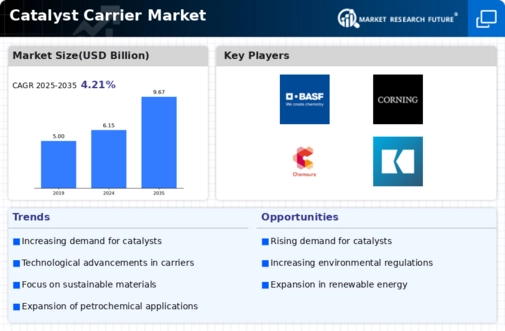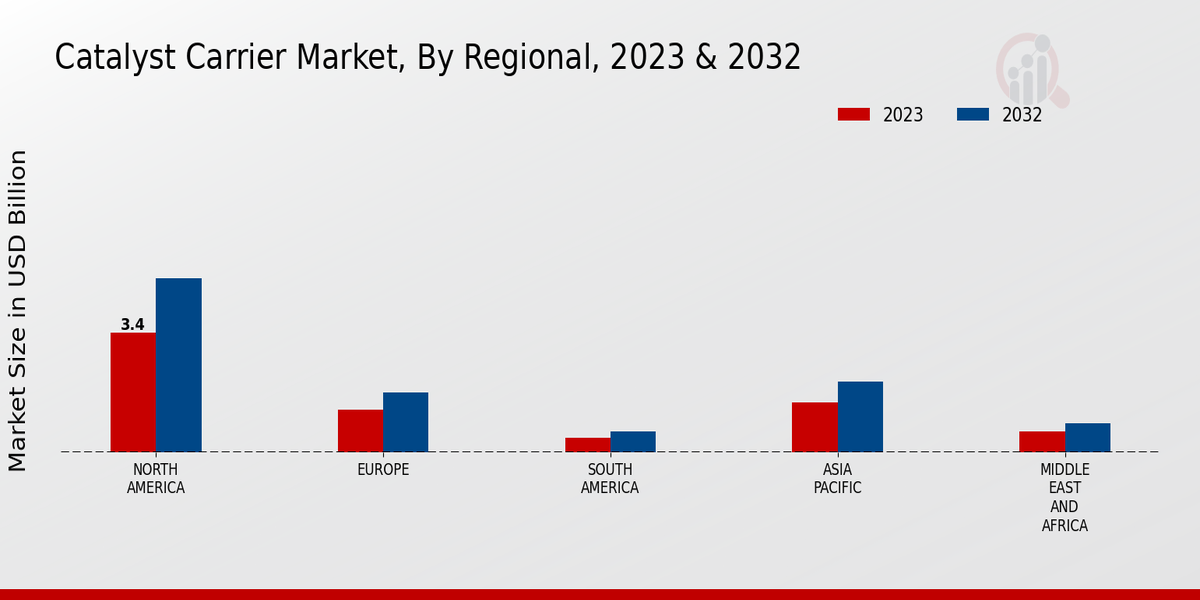Market Trends and Projections
The Global Catalyst Carrier Market Industry is poised for significant growth, with projections indicating a market size of 6.15 USD Billion in 2024 and a potential increase to 9.67 USD Billion by 2035. The anticipated CAGR of 4.2% from 2025 to 2035 reflects the ongoing demand for catalyst carriers across various sectors. Key trends include the adoption of advanced materials, increased regulatory pressures, and the expansion of chemical processing industries. These factors collectively contribute to a dynamic market landscape, where innovation and compliance drive the evolution of catalyst carrier technologies.
Emerging Markets and Economic Growth
The emergence of developing economies is contributing to the expansion of the Global Catalyst Carrier Market Industry. Countries in Asia-Pacific and Latin America are experiencing rapid industrialization, which is driving the demand for catalysts in various applications. As these economies grow, there is an increasing need for efficient catalyst carriers to support the burgeoning chemical and petrochemical industries. This growth is likely to be accompanied by investments in infrastructure and technology, further enhancing the market's prospects. The combination of economic growth and industrial expansion in these regions is expected to play a pivotal role in shaping the future of the catalyst carrier market.
Increasing Environmental Regulations
The imposition of stringent environmental regulations globally is a key driver for the Global Catalyst Carrier Market Industry. Governments are increasingly mandating the use of catalysts to minimize harmful emissions from industrial processes. This regulatory landscape compels manufacturers to invest in advanced catalyst carriers that can meet these requirements. For instance, the introduction of regulations aimed at reducing greenhouse gas emissions has led to a surge in demand for high-performance catalyst carriers in various sectors, including energy and manufacturing. This trend is expected to sustain the market's growth, as compliance with environmental standards becomes a critical priority for industries.
Rising Demand for Catalytic Converters
The increasing global demand for catalytic converters in automotive applications drives the Global Catalyst Carrier Market Industry. As governments worldwide implement stricter emission regulations, manufacturers are compelled to enhance their catalytic systems. This trend is evident in regions like Europe and North America, where emissions standards are becoming more stringent. The market is projected to reach 6.15 USD Billion in 2024, reflecting the growing need for efficient catalyst carriers that can support advanced catalytic technologies. This demand is likely to continue, as the automotive sector increasingly prioritizes sustainability and environmental compliance.
Technological Advancements in Catalysis
Technological innovations in catalysis are reshaping the Global Catalyst Carrier Market Industry. The development of novel materials and methods for catalyst support enhances the performance and longevity of catalysts. For example, advancements in nanotechnology and the use of advanced porous materials are enabling the creation of more efficient catalyst carriers. These innovations not only improve reaction rates but also reduce the overall costs associated with catalyst production and usage. As these technologies continue to evolve, they are likely to attract investments, further propelling the market's growth at a CAGR of 4.2% from 2025 to 2035.
Growth in Chemical Processing Industries
The expansion of chemical processing industries significantly influences the Global Catalyst Carrier Market Industry. As industries such as petrochemicals, pharmaceuticals, and agrochemicals grow, the need for effective catalyst carriers becomes paramount. These carriers enhance the efficiency of chemical reactions, leading to higher yields and reduced waste. For instance, the petrochemical sector is expected to witness substantial growth, thereby increasing the demand for specialized catalyst carriers. This trend is expected to contribute to the market's growth trajectory, with projections indicating a rise to 9.67 USD Billion by 2035, driven by the ongoing advancements in chemical processing technologies.






